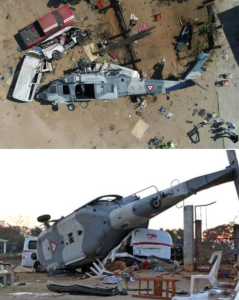14 Killed as Military Helicopter Crashes in Mexico: What We Know So Far
Tragedy struck the skies of northern Mexico yesterday when a military helicopter crashed during a routine patrol mission, killing all 14 personnel on board. The incident, confirmed by Mexico’s Ministry of Defense (SEDENA), has sent shockwaves throughout the nation, highlighting both the risks faced by military forces and the urgent need for answers about what went wrong.
The Crash
At approximately 10:15 AM local time, the helicopter—a UH-60 Black Hawk—went down in a remote mountainous region near the municipality of Guadalupe y Calvo, in the northern state of Chihuahua. The aircraft was reportedly returning to base after a security reconnaissance operation linked to ongoing anti-cartel efforts in the region.
Witnesses in a nearby rural community described hearing a low-flying chopper followed by a loud explosion. Some locals initially mistook the sound for gunfire, a common occurrence in cartel-dominated territories. Moments later, a plume of thick black smoke was visible from several kilometers away.
Local search and rescue teams, assisted by nearby military personnel, rushed to the site, but there were no survivors.
Victims Identified
The 14 individuals aboard the helicopter included 11 members of the Mexican Army and three Air Force personnel. Among the deceased was Lieutenant Colonel Gerardo Martínez, the aircraft commander, who had served for over 20 years and was known for his leadership in numerous high-risk operations.
Families of the victims have been notified, and flags across military installations are flying at half-mast in honor of the fallen soldiers.
In a statement released shortly after the crash, Defense Secretary Luis Cresencio Sandoval said:
“We are deeply saddened by this terrible loss. These brave men gave their lives in service to our nation. Our hearts are with their families, and we pledge to fully investigate the cause of this accident.”
The Mission
Though the exact details of the operation remain classified, sources close to the investigation confirmed the helicopter was involved in a surveillance patrol near cartel-controlled territory. This region of Chihuahua has been notorious for clashes between rival drug organizations, most notably the Sinaloa and Juárez cartels.
The Mexican military has increasingly relied on helicopters to navigate the rugged terrain and conduct rapid-response operations against drug trafficking and illegal mining. This mission, however, was described as “routine,” with no indication the aircraft had come under enemy fire.
That hasn’t stopped speculation from swirling.
Was the Helicopter Shot Down?
As news of the crash spread, rumors circulated on social media that the helicopter may have been shot down. Unverified videos began surfacing online, with some claiming to show gunfire in the direction of a chopper minutes before the crash.
However, military officials were quick to dismiss these reports as unfounded.
“There is no evidence, at this time, to suggest that the aircraft was brought down by hostile action,” said General Alejandro Vega, a spokesperson for the Armed Forces. “We urge the public not to spread misinformation as we work to determine the truth.”
The official investigation is now underway, led by a joint task force from SEDENA, the Mexican Civil Aviation Authority, and the U.S. National Transportation Safety Board (NTSB), which is providing technical support due to the American-made Black Hawk model involved.
Preliminary Findings
While the full crash report could take weeks or even months to complete, early indications point to a catastrophic mechanical failure.
According to an internal memo leaked to several media outlets, the pilot reported “instrument instability” and requested clearance for an emergency return to base just four minutes before the crash. Communication was lost shortly thereafter.
Weather conditions in the region at the time were said to be “challenging but manageable,” with low cloud cover and moderate wind gusts—nothing that would normally ground a mission.
Some aviation analysts have pointed to possible engine failure or rotor malfunction as the most likely cause.
Public Reaction
President Andrés Manuel López Obrador addressed the nation in his morning press conference, offering condolences and promising full transparency:
“These soldiers died in the line of duty, working to protect our people. Their sacrifice will not be forgotten. We will honor their legacy by ensuring their families are supported and that the cause of this tragedy is thoroughly investigated.”
Thousands of citizens took to social media to express their grief and respect for the fallen heroes. Hashtags like #HéroesDeMéxico and #HelicopterCrash quickly trended nationwide.
Several military families, however, voiced concern about the aging condition of much of Mexico’s military fleet. One anonymous source within the Army stated that while Black Hawks are highly respected machines, several of those in the Mexican inventory have been in use since the early 2000s with limited upgrades.
Political Fallout?
The crash has also triggered renewed debate within Mexico’s Congress about military spending and accountability. Opposition leaders have called for an emergency review of the Air Force’s maintenance protocols and procurement policies.
“There must be consequences if this was due to negligence or outdated equipment,” said Senator María Delgado of the National Action Party (PAN). “Our armed forces deserve the best tools to carry out their dangerous work.”
Some lawmakers are pushing for an audit of the Defense Ministry’s current helicopter fleet, demanding a full report on the safety records of all operational aircraft.
Looking Ahead
A national day of mourning has been declared, and funerals for the victims will be held with full military honors over the coming week. In Mexico City, a candlelight vigil is being planned outside the National Palace.
As the investigation proceeds, families are left waiting for answers, hoping that the tragedy that claimed the lives of 14 servicemen will not be in vain—but will instead spark real change in military safety standards.
In a country already grappling with violence, corruption, and political division, the loss of these 14 men is a stark reminder of the dangers that linger far above the frontlines.

